5-Lipoxygenase reaction products modulate alveolar macrophage phagocytosis of Klebsiella pneumoniae
- PMID: 9784515
- PMCID: PMC108641
- DOI: 10.1128/IAI.66.11.5140-5146.1998
5-Lipoxygenase reaction products modulate alveolar macrophage phagocytosis of Klebsiella pneumoniae
Abstract
The leukotrienes are potent lipid mediators of inflammation formed by the 5-lipoxygenase-catalyzed oxidation of arachidonic acid. Although the effects of leukotrienes on neutrophil chemotaxis and activation have been established, their role in modulating innate host defense mechanisms is poorly understood. In a previous study (M. Bailie, T. Standiford, L. Laichalk, M. Coffey, R. Strieter, and M. Peters-Golden, J. Immunol. 157:5221-5224, 1996), we used 5-lipoxygenase knockout mice to establish a critical role for endogenous leukotrienes in pulmonary clearance and alveolar macrophage phagocytosis of Klebsiella pneumoniae. In the present study, we investigated the role of specific endogenous leukotrienes in phagocytosis of K. pneumoniae and explored the possibility that exogenous leukotrienes could restore phagocytosis in alveolar macrophages with endogenous leukotriene synthesis inhibition and enhance this process in leukotriene-competent cells. Rat alveolar macrophages produced leukotriene B4 (LTB4), LTC4, and 5-hydoxyeicosatetraenoic acid (5-HETE) during the process of phagocytosis, and the inhibition of endogenous leukotriene synthesis with zileuton and MK-886 dramatically attenuated phagocytosis. We also observed a reduction in phagocytosis when we treated alveolar macrophages with antagonists to the plasma membrane receptors for either LTB4, cysteinyl-leukotrienes, or both. In leukotriene-competent cells, LTC4 augmented phagocytosis to the greatest extent, followed by 5-HETE and LTB4. These 5-lipoxygenase reaction products demonstrated similar relative abilities to reconstitute phagocytosis in zileuton-treated rat alveolar macrophages and in alveolar macrophages from 5-lipoxygenase knockout mice. We conclude that endogenous synthesis of all major 5-lipoxygenase reaction products plays an essential role in phagocytosis. The restorative and pharmacologic effects of LTC4, LTB4, and 5-HETE may provide a basis for their exogenous administration as an adjunctive treatment for patients with gram-negative bacterial pneumonia.
Figures

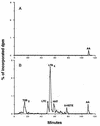

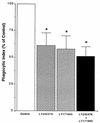
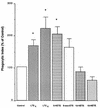
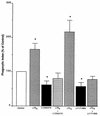
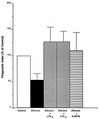
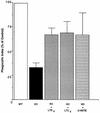
Similar articles
-
Leukotriene B4 augments neutrophil phagocytosis of Klebsiella pneumoniae.Infect Immun. 2001 Apr;69(4):2011-6. doi: 10.1128/IAI.69.4.2011-2016.2001. Infect Immun. 2001. PMID: 11254552 Free PMC article.
-
Leukotriene-deficient mice manifest enhanced lethality from Klebsiella pneumonia in association with decreased alveolar macrophage phagocytic and bactericidal activities.J Immunol. 1996 Dec 15;157(12):5221-4. J Immunol. 1996. PMID: 8955165
-
Leptin-deficient mice exhibit impaired host defense in Gram-negative pneumonia.J Immunol. 2002 Apr 15;168(8):4018-24. doi: 10.4049/jimmunol.168.8.4018. J Immunol. 2002. PMID: 11937559
-
5-Lipoxygenase: a target for antiinflammatory drugs revisited.Curr Med Chem. 1999 Jan;6(1):71-85. Curr Med Chem. 1999. PMID: 9873115 Review.
-
Leukotriene synthesis inhibitors versus antagonists: the pros and cons.Curr Allergy Asthma Rep. 2007 May;7(2):126-33. doi: 10.1007/s11882-007-0010-6. Curr Allergy Asthma Rep. 2007. PMID: 17437683 Review.
Cited by
-
Metabolites of prostaglandin synthases as potential biomarkers of Lyme disease severity and symptom resolution.Inflamm Res. 2019 Jan;68(1):7-17. doi: 10.1007/s00011-018-1180-5. Epub 2018 Aug 18. Inflamm Res. 2019. PMID: 30121835 Free PMC article.
-
Stimulatory Effects of Peroxisome Proliferator-Activated Receptor-gamma on Fcgamma Receptor-Mediated Phagocytosis by Alveolar Macrophages.PPAR Res. 2007;2007:52546. doi: 10.1155/2007/52546. PPAR Res. 2007. PMID: 18253476 Free PMC article.
-
Leukotriene B4-receptor-1 mediated host response shapes gut microbiota and controls colon tumor progression.Oncoimmunology. 2017 Aug 10;6(12):e1361593. doi: 10.1080/2162402X.2017.1361593. eCollection 2017. Oncoimmunology. 2017. PMID: 29209564 Free PMC article.
-
Inhibition of host 5-lipoxygenase reduces overexuberant inflammatory responses and mortality associated with Cryptococcus meningoencephalitis.mBio. 2024 Sep 11;15(9):e0148324. doi: 10.1128/mbio.01483-24. Epub 2024 Jul 31. mBio. 2024. PMID: 39082787 Free PMC article.
-
Platelet particle formation by anti GPIIIa49-66 Ab, Ca2+ ionophore A23187, and phorbol myristate acetate is induced by reactive oxygen species and inhibited by dexamethasone blockade of platelet phospholipase A2, 12-lipoxygenase, and NADPH oxidase.Blood. 2007 Sep 15;110(6):1989-96. doi: 10.1182/blood-2006-10-054064. Epub 2007 Jun 1. Blood. 2007. PMID: 17545506 Free PMC article.
References
-
- Bailie M, Standiford T, Laichalk L, Coffey M, Strieter R, Peters-Golden M. Leukotriene-deficient mice manifest enhanced lethality from Klebsiella pneumoniae in association with decreased alveolar macrophage phagocytic and bactericidal activities. J Immunol. 1996;157:5221–5224. - PubMed
-
- Balter M, Toews G, Peters-Golden M. Multiple defects in arachidonate metabolism in alveolar macrophages from young asymptomatic smokers. J Lab Clin Med. 1989;114:662–673. - PubMed
-
- Carter G, Young P, Albert D, Bouska J, Dyer R, Bell R, Summers J, Brooks D. 5-Lipoxygenase inhibitory activity of zileuton. J Pharmacol Exp Ther. 1991;256:929–937. - PubMed
Publication types
MeSH terms
Substances
Grants and funding
LinkOut - more resources
Full Text Sources

